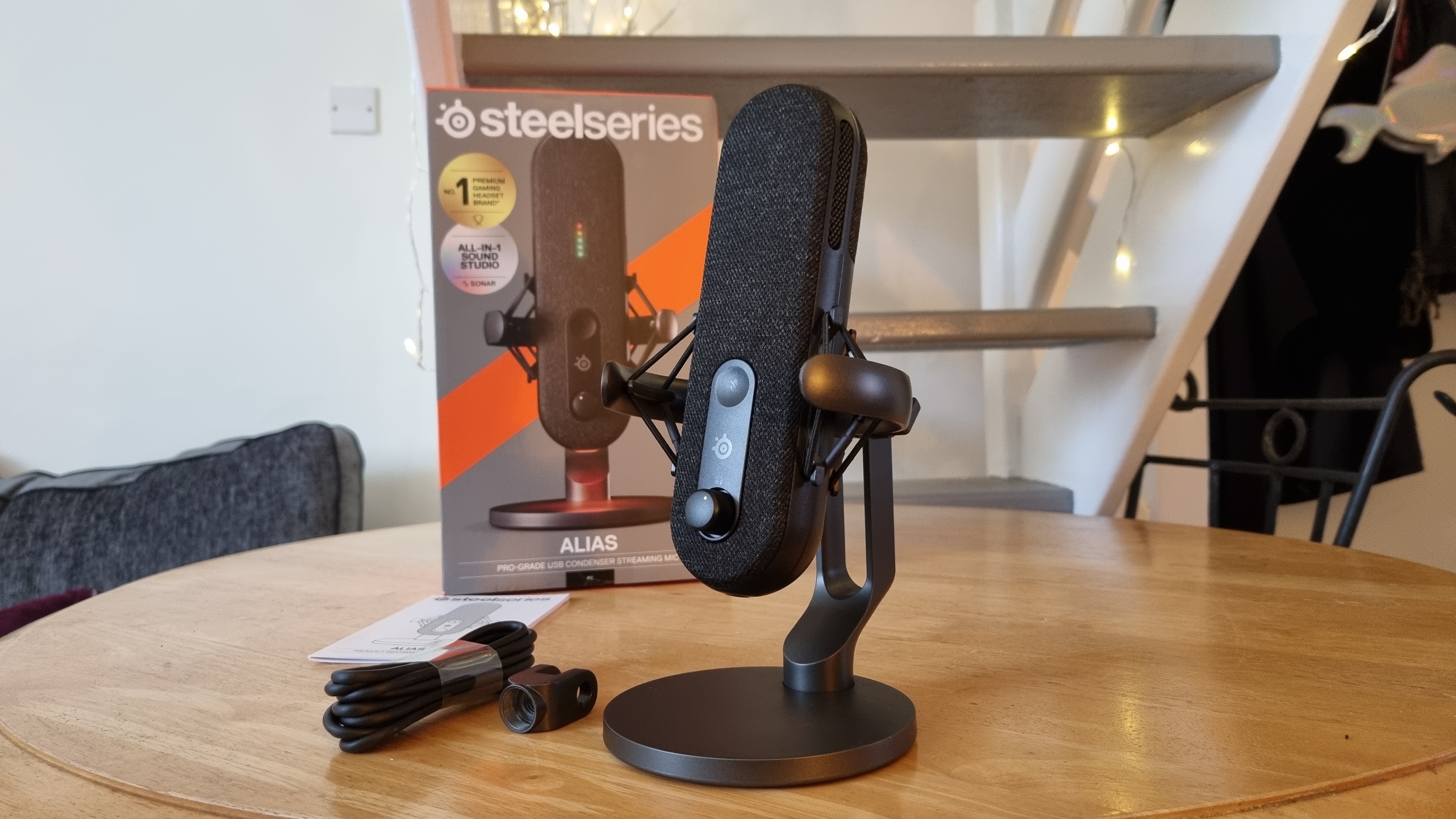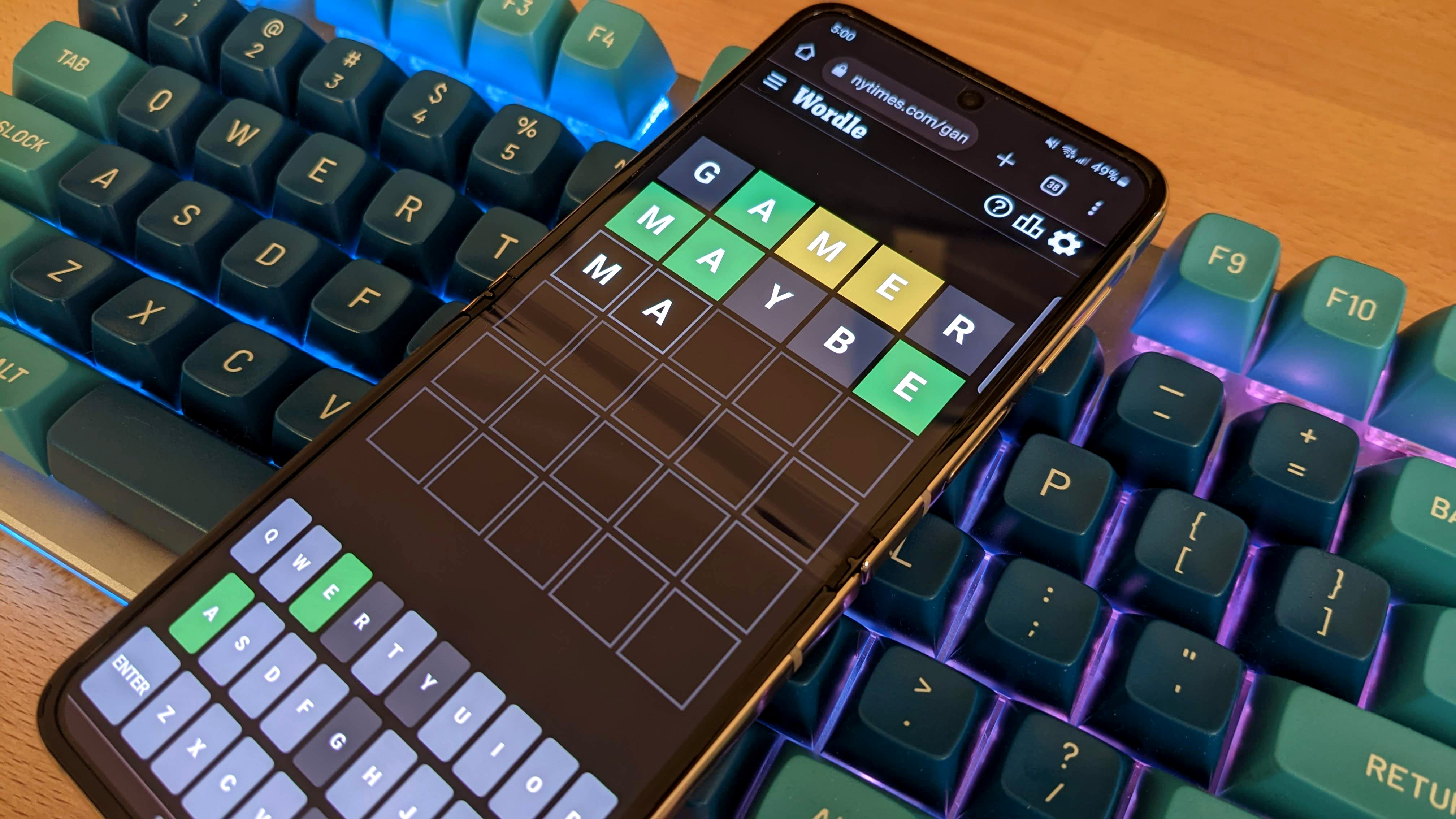
A decent sounding mic in a very compact package, but whether it justifies its price tag might take some serious thought.
Audio gear, including some of the best microphones, can be bulky pieces of equipment to accommodate on your desk. As someone that’s become intimately familiar with the downsides of working within a limited amount of space, it can become tempting to think that it’s easier to use a (usually lesser) headset mic over a standalone unit, even if it means sacrificing some audio quality for your next meeting or stream.
However, SteelSeries’ Alias microphone aims to pack everything a gamer might want in a mic in a compact setup, even going as far as to say it’s the first mic “truly designed for gaming”. With an MSRP of $180/£180, it certainly has a premium price tag attached, but first impressions out of the box does reveal a premium looking product to match.
Nestled inside a small but well-constructed shock mount, the slim chassis and narrow but still substantial looking microphone design makes for a good-looking addition to your setup, and quickly managed to tuck itself amongst my overcrowded desk without making things feel any more cluttered than they already are.
At 720g with the included desk stand it treads the line between feeling weighty enough to assure you it’s a premium piece of gear, without being heavy or cumbersome to move around.
More than that, the metal construction and anodized finish looks reassuringly professional, which means that if you had it in shot for a conference call it’s unlikely to stand out. Given its size though, it’s easy enough to hide if you don’t want it making an appearance. Built into the front face of the mic is a lozenge-shaped control interface with a mute button and headphone gain dial, which is nicely dampened and satisfying to turn.
It might sound strange to some, but having used audio gear with plastic-y, wobbly control interfaces and dials that feel more like they should control children’s toys instead of professional equipment, a nice-feeling dial or two really does make a difference to how you perceive your new bit of kit.
Gain adjustment is handled by another excellent feeling dial on the rear, which although a little fiddly at first makes sense. Adjusting gain levels is usually more of a setup thing than something you’re likely to be doing on the regular, and given the ease at which the unit can be moved around I didn’t find reaching around the back to adjust the gain all that much of a hassle.
(Image credit: Andy Edser)
Also around the back is a 3.5mm audio jack for headphone monitoring, which keeps it out of the way but might be a bit of a pain if you’re planning on plugging and unplugging your headphones often.
The included USB-C to USB-A cable threads through the stand to its port on the rear, and once it’s connected there’s a hidden RGB light under the mic chassis that projects a discrete glow onto the stand beneath.
Speaking of lights, the Alias hides its LED indicators beneath the fabric mic cover so the gain level shines through only when it’s picking up audio, and those same LEDs also display a large red “X” when the unit is muted. That’s a nice touch, as trying to figure out which mute setting you’ve accidentally left on mid-meeting or recording session can be a panic-inducing moment, so at least you’ll be sure if the microphone itself is muted or not.
The SteelSeries Alias showing off its hidden LED mute feature. (Image credit: Andy Edser)
Using SteelSeries’ Sonar audio software I was able to quickly set up to record and stream to various other applications with ease, thanks to its intuitive drag and drop system for handling inputs and outputs. This was made especially easy since the software performed a quick and accurate setup on first boot that recognised all of my plugged in audio gear immediately, and quickly configured everything hardware-wise with minimal prompting.
The fact that this worked as well as it did struck me as a minor miracle, as up until this point I was unaware that any audio configurators existed that didn’t require at least a few minutes of messing around and some colourful language to get everything working the way you intended it to.
The software also includes an adjustable equaliser with a variety of useful presets, a compressor and a noise suppressor, and as someone who’s used to the intricacies of various audio interfaces I was impressed by how straightforward the whole process was. Audio set up can be notoriously fiddly, but Sonar lays things out in an easy to understand and intuitive way with all the adjustment you could reasonably need, without a barrage of settings you probably don’t.
(Image credit: SteelSeries)
When it comes to sound, the Alias makes use of a 1-inch/25mm capsule, which for reference is much larger than something like the 14mm capsule you’d find in the Blue Yeti, while frequency response ranges from 50Hz to 20kHz in a single cardioid pickup pattern with a max SPL of 120 dB. Impressive stuff on paper, but what about the audio itself?
First impressions were good, as there’s a decent level of fidelity here even when the mic is a reasonable distance away. That large capsule mean that low-end frequencies and mids keep their heft, trebles are clear without becoming harsh, and overall there’s a good depth to the tone.
A fair bit of background noise from my fans can be heard when the audio is raw, but listen to the clips below, one raw and one with the EQ, compressor and ClearCast AI noise reduction turned on, and hear how much more focussed the sound becomes.
I’ll be honest and say that even with the software’s help the audio isn’t as crispy and clear as some of the comparisons above, but given it’s a condenser unit sitting at a reasonable distance, the fact it achieved a decent level of richness while maintaining good clarity was impressive. Some cheaper mics can lean towards sounding tinny, whereas if anything the Alias leans towards a slightly fuller tone.
Playing around with the EQ presets yielded a variety of useful options, and I found that they were well-labelled for their particular purposes, with the “balanced” preset (used in the processed clip above) providing the most, you guessed it, balanced and clear sound.
The noise-suppressor here is SteelSeries’ AI-enhanced ClearCast, and I found it was remarkably good at discerning between my voice and unwanted background noise, and I didn’t have to turn it up very high to get a good result. Like all noise-reduction software it can get a little over-zealous and robotic sounding at higher settings, but when kept at a reasonable setting I found it worked very well for its purpose.
✅ If you need good audio at a distance: The SteelSeries Alias picks up well from a desktop position, and the Sonar noise cancelling is excellent.
✅ If you’re looking for hassle-free recording: Take it from someone who’s seen his fair share of fiddly audio interfaces—SteelSeries’ Sonar audio software is about as straightforward as you’re going to get.
❌ If you’re on a tight budget: The Alias might have a premium feel, but it comes with a premium price tag to match.
❌ If you’re looking for streamer-style audio: The Alias does well in a desktop position, but you’ll still want something further up the stack like the Shure MV7 if you want ultimate vocal capture.
If you’re looking for something that can stand on your desk with minimal footprint and capture good audio for gaming, meetings and more without any fuss, then the standard Alias makes a lot of sense. Thanks to the power and ease of use of the Sonar software it’s a set and forget sort of setup, all wrapped up in a neat and unobtrusive package.
That being said, when listening back to my sound samples in comparison to mics that we’ve already tested like the HyperX Quadcast X or the Sennheiser Profile Streaming Set it does make me wonder whether the regular Alias does enough to justify that $180 price tag.
It certainly sounds decent and the build quality is impressive, but there’s just no getting around the fact that it’s a lot of money for a single mic with no extras, even if the results are good and the software is very impressive. Spend a bit more and you could be in premium audio territory with the likes of the Shure MV7, whereas the Razer Seiren Mini at $50 gets similar audio results, albeit without the fancy lighting and premium finish.
Regardless, although the Alias is a somewhat pricey affair, its performance, build quality and ease of use does stack up to make a compelling package. What you end up with here is a compact mic that you can stick in a corner of your desk, crank up the noise cancelling, and forget about.
Perhaps its peace of mind you’re buying with the Alias. No fuss, no hassles, just a solidly built, good looking bit of kit that does what it says it will, and for that matter, does it well.






